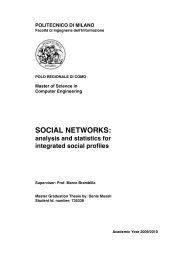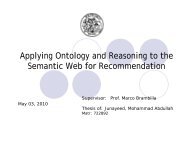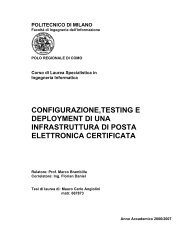Thesis full text (PDF) - Politecnico di Milano
Thesis full text (PDF) - Politecnico di Milano
Thesis full text (PDF) - Politecnico di Milano
You also want an ePaper? Increase the reach of your titles
YUMPU automatically turns print PDFs into web optimized ePapers that Google loves.
serializations. Such separation grants the independence from the specific reasoning engine and<br />
from the UML serialization format.<br />
Controller<br />
(Servlet)<br />
Actions<br />
(Java classes)<br />
Page Services<br />
(Java classes)<br />
Knowledge Base Interface<br />
(Java)<br />
Web<br />
browser<br />
WEB<br />
Web<br />
server<br />
View<br />
(JSP)<br />
State Objects<br />
(Java)<br />
Knowledge<br />
Exploration<br />
Unit Services<br />
(Java classes)<br />
Tableau<br />
Reasoner<br />
Internalization<br />
TBox<br />
Absorption<br />
Symbols<br />
Components Interaction<br />
HTTP/SOAP messages<br />
Component<br />
Servlet Container<br />
Knowledge<br />
Management<br />
Operation Services<br />
(Java classes)<br />
Business Logic<br />
Service<br />
Species Validation &<br />
Ontology Repair<br />
Knowledge Layer - Pellet<br />
XMI<br />
Subcomponent<br />
Application Server<br />
Data Layer<br />
Figure 4.3: Runtime architecture for the framework<br />
4.3 Implementation of Components<br />
As we have mentioned earlier, the framework components are specified as new WebML<br />
primitives. For their implementation we exploit the WebRatio plug-in mechanism, which allows<br />
to define new units and to seamlessly integrate them in the design and execution of the<br />
applications. In the following we describe the list of new WebML units that have been defined as<br />
implementations of the components <strong>di</strong>scussed in Section 3.<br />
4.3.1 Content publishing units<br />
The Hierarchy, Class, Datatype, Property, Property Value, Instance, and Explanation<br />
components are implemented as content units. The UML classes acting as selection con<strong>di</strong>tions<br />
for the correspon<strong>di</strong>ng UML component are defined for the respective content unit, with values<br />
being parametric on the user choices. The units produce in output the names of the deducted<br />
elements. Table 4.1 summarizes the Hierarchy components together with their symbol, the<br />
expected inputs and delivered outputs. The remaining exploration components are summarized in<br />
table 4.2.<br />
70


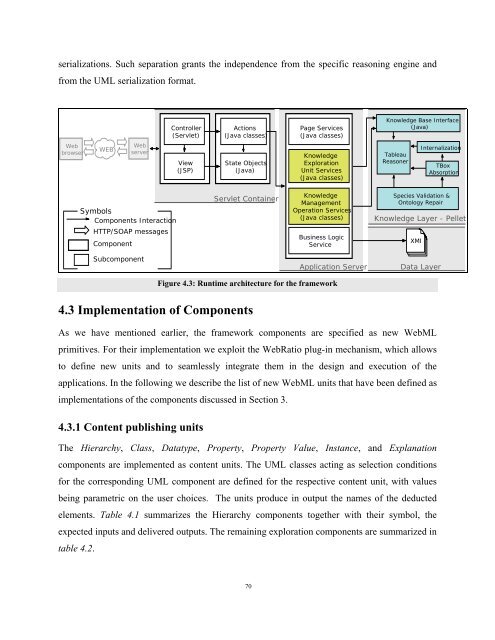
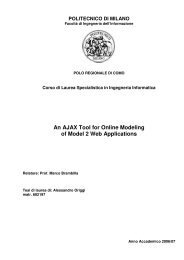
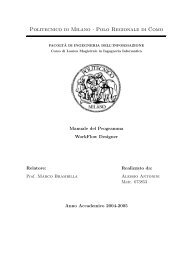
![Full text preview of the chapter [PDF] - Politecnico di Milano](https://img.yumpu.com/44021924/1/180x260/full-text-preview-of-the-chapter-pdf-politecnico-di-milano.jpg?quality=85)
